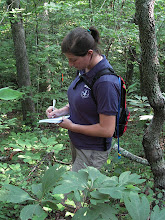
Sometimes I feel like one of the Hardy Boys in my role as an amateur detective...
One intensely hot August day in 2007, I sat on the fresh-swept porch of the Williams House and dug out photo after photo from a a cardboard box that was somewhat shredded from the gnawing of mice over the years. Babies, cows, riverbeds--images of lost years and lives and landscapes came into view. In one picture, several women with indistinguishable faces posed on a rocky precipice. Where was this? Why were the women dolled up in heels and hairdos in such a seemingly rugged place?
A possible solution came soon thereafter during a trip to the Huntsville Historical Society. I was rifling through a book on the history of St. Paul and recognized a similar outcrop in another photo. This time, however, a new set of faces beamed up in black and white. The caption informed me that the bluff was atop Chimney Rock Mountain, located just south of the White River from Williams Woods. According to tradition, the site was known as a lookout for the first settlers. It became a popular picnic spot for church and community gatherings. In St. Paul's heyday, a resort was planned for the top of the mountain because the spring was said to have healing powers. Unfortunately, the benefactor died soon after a road was constructed to the top and grass seed was sown. Plans did not continue, and the decline of St. Paul in the 1930s saw to it that most development was stymied for the long term.
The bluff at Chimney Rock Mountain is now part of the Ozark National Forest and can be reached on foot. Anyone up for an adventure?


 the Northwest Quarter of the Northwest Quarter (NW 1/4), containing 40 acres, more or less, being in Section 33, Township 14 North, Range 26 West." The
the Northwest Quarter of the Northwest Quarter (NW 1/4), containing 40 acres, more or less, being in Section 33, Township 14 North, Range 26 West." The 




